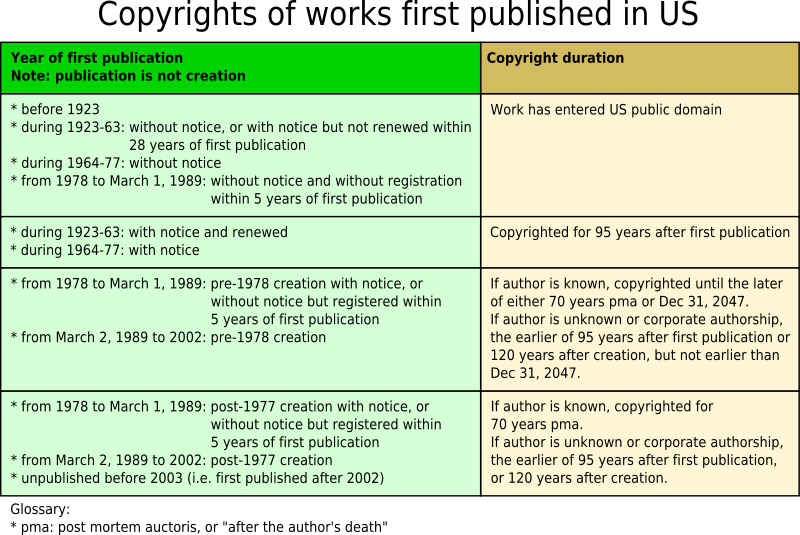Two examples of material in the public domain are United States government works, and writings for which their copyright has expired. Work created by the federal government is in the public domain (but not work created by state of local governments). In the United States, anything published before 1923 no longer has copyright protection and is in the public domain.[1] Laws vary by country, but in most of the world, works whose authors died at least 50, 70, or 100 years ago are in the public domain. (the 1923 cut-off date applies only to the U.S. This means foreign works first published before 1923 are in the public domain in the U.S., but may still be copyrighted outside the U.S.)
Fair use is not needed when copying material that is in the public domain because there is no copyright holder. However, physical access to the works may be controlled by a museum that makes users promise not to make any reproductions. Texts and images published in the U.S. before January 1, 1923 are in the public domain. (Because of legislation passed in 1998, no new works will fall into the public domain until 2019, when works published in 1923 will expire. In 2020, works published in 1924 will expire, and so on. For works published after 1977, if the work was written by a single author, the copyright will not expire until 70 years after the author’s death. [2]) Before the Copyright Act of 1976, copyright expired after 28 years and had to be renewed for an additional 28 year term; items published prior to 1964 that were not renewed are in the public domain.[3] Items that were published in the USA before 1989 without a copyright notice are, with a few exceptions, in the public domain. Works originally published in the U.S. after 2002 (with or without copyright notice or registration) are protected until 70 years after the author's death. [4] [5]
Through the Berne Convention Implementation Act, (effective March 1, 1989) copyright is automatic; no registration is needed and it is not necessary to display a © notice to be copyright protected. [6]
A very useful chart: Copyright Term and the Public Domain in the United States. by Peter B. Hirtle. (Last updated 3 January, 2014). Cornell Copyright Information Center [7]
 A chart of the copyright durations of US works, by Jappalang.
A chart of the copyright durations of US works, by Jappalang.
On 1 March 1989, the U.S. Berne Convention Implementation Act of 1988 was enacted, and the U.S. Senate ratified the treaty, making the United States a party to the Berne Convention. Both the Senate and the House of Representatives passed legislation to bring United States laws into conformity with the Bern treaty. Summary of the Berne Convention for the Protection of Literary and Artistic Works. In the United States, determining whether a work has entered the public domain or is still under copyright can be quite complex, primarily because copyright terms have been extended multiple times and in different ways—shifting over the course of the 20th century from a fixed-term based on first publication, with a possible renewal term, to a term extending to fifty, then seventy, years after the death of the author. US Copyright Office, Copyright Basics.
See also
External links
- How Can I Tell Whether a Book Can Go Online? Guidance from the University of Pennsylvania Online Books project.
- FAIR USE - PUBLIC DOMAIN An introduction to copyright terms and a discussion of Bridgeman vs Corel.
- Ongoing list of books in the public domain
- US Copyright Laws; a summary.
- WHEN U.S. WORKS PASS INTO THE PUBLIC DOMAIN.
References
- ↑ Public Domain
- ↑ Welcome to the Public Domain.
- ↑ For a list of renewals see the Project Gutenberg collections at [1], which cover everything except music.
- ↑ Copyright Term and the Public Domain in the United States.
- ↑ WHEN U.S. WORKS PASS INTO THE PUBLIC DOMAIN.
- ↑ Definitions. U.S. Copyright Office.
- ↑ Cornell Copyright Information Center.
